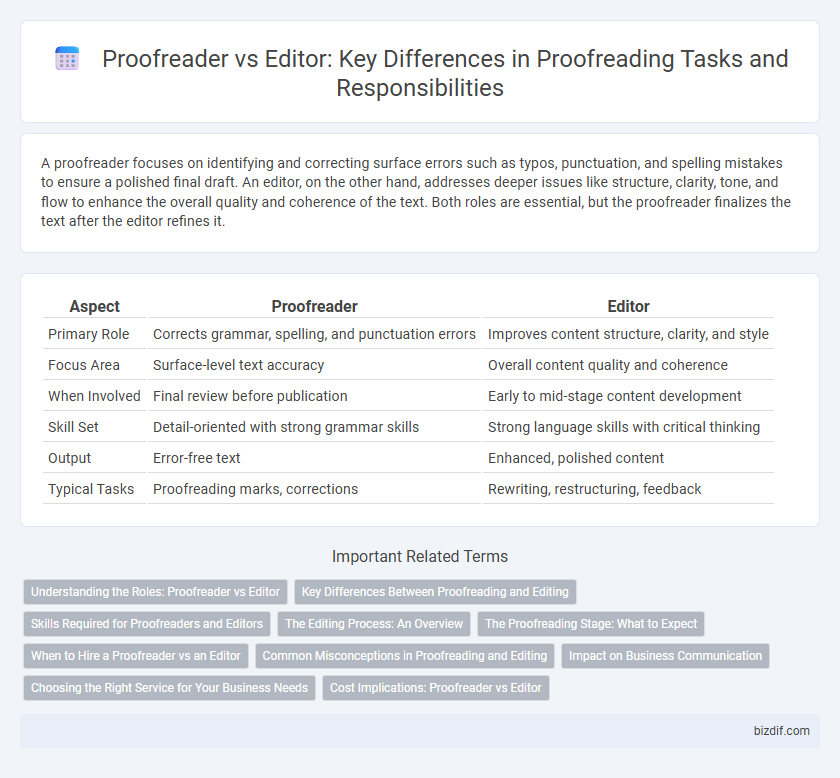A proofreader focuses on identifying and correcting surface errors such as typos, punctuation, and spelling mistakes to ensure a polished final draft. An editor, on the other hand, addresses deeper issues like structure, clarity, tone, and flow to enhance the overall quality and coherence of the text. Both roles are essential, but the proofreader finalizes the text after the editor refines it.
Table of Comparison
| Aspect | Proofreader | Editor |
|---|---|---|
| Primary Role | Corrects grammar, spelling, and punctuation errors | Improves content structure, clarity, and style |
| Focus Area | Surface-level text accuracy | Overall content quality and coherence |
| When Involved | Final review before publication | Early to mid-stage content development |
| Skill Set | Detail-oriented with strong grammar skills | Strong language skills with critical thinking |
| Output | Error-free text | Enhanced, polished content |
| Typical Tasks | Proofreading marks, corrections | Rewriting, restructuring, feedback |
Understanding the Roles: Proofreader vs Editor
Proofreaders focus on identifying and correcting surface errors such as typos, grammar mistakes, punctuation, and formatting inconsistencies to ensure a polished final text. Editors engage in deeper content analysis, addressing structure, clarity, tone, and overall coherence to enhance readability and alignment with the target audience. Understanding these distinct roles helps writers allocate resources effectively and achieve a higher-quality manuscript.
Key Differences Between Proofreading and Editing
Proofreading focuses on identifying and correcting surface errors such as grammar, spelling, punctuation, and formatting inconsistencies, ensuring the text is polished and error-free. Editing involves a deeper analysis that includes improving the structure, clarity, style, tone, and overall flow of the content to enhance readability and effectiveness. While proofreaders finalize the text for publication, editors reshape and refine the content for coherence and impact.
Skills Required for Proofreaders and Editors
Proofreaders require exceptional attention to detail, strong grammar proficiency, and the ability to spot typographical errors and inconsistencies in text. Editors need advanced skills in content organization, style refinement, and contextual understanding to enhance clarity, coherence, and overall narrative flow. Both roles demand a deep knowledge of language rules, but editors often possess additional expertise in subject matter and strategic communication.
The Editing Process: An Overview
The editing process involves a comprehensive review of content focusing on clarity, style, and structure, while proofreading primarily addresses surface-level errors such as grammar, spelling, and punctuation. Editors reshape sentences, enhance flow, and ensure consistency across the document, often engaging in multiple revision rounds. Proofreaders perform the final quality check to catch any overlooked mistakes before publication.
The Proofreading Stage: What to Expect
The proofreading stage focuses on identifying and correcting surface errors such as typos, grammar mistakes, punctuation, and formatting inconsistencies. Proofreaders ensure the final manuscript is polished and error-free before publication, while editors address deeper issues like content structure, clarity, and style earlier in the process. Expect a meticulous review during proofreading that highlights minor corrections to enhance readability and maintain consistency.
When to Hire a Proofreader vs an Editor
Hire a proofreader when you need to catch surface errors such as typos, grammar mistakes, and punctuation issues to ensure a polished final draft. Opt for an editor when the content requires structural improvements, clarity enhancement, style consistency, or developmental feedback. Understanding these distinctions improves the quality and effectiveness of your written work.
Common Misconceptions in Proofreading and Editing
Proofreaders focus on identifying and correcting surface errors such as spelling, grammar, and punctuation, while editors improve content structure, style, and clarity. A common misconception is that proofreading and editing are interchangeable roles, but proofreading is the final check before publication. Understanding this distinction ensures precise communication and error-free documents.
Impact on Business Communication
Proofreaders ensure the accuracy and clarity of business documents by correcting grammar, spelling, and punctuation errors, which enhances professionalism and credibility. Editors go beyond surface-level corrections, refining tone, style, and structure to align content with the company's brand voice and strategic goals. Effective collaboration between proofreaders and editors significantly improves business communication by delivering polished, coherent, and persuasive messages that build trust with clients and stakeholders.
Choosing the Right Service for Your Business Needs
Selecting between a proofreader and an editor depends on your business goals: proofreaders specialize in catching grammatical, punctuation, and typographical errors to ensure polished, error-free content, while editors enhance structure, clarity, and overall flow to improve readability and effectiveness. For content requiring surface-level corrections, proofreading is ideal; for substantial revisions targeting organization and style, editing is essential. Understanding these distinctions optimizes your investment in quality content tailored to your business needs.
Cost Implications: Proofreader vs Editor
Proofreaders typically charge lower rates than editors due to the narrower focus on correcting grammar, spelling, and punctuation errors. Editors often demand higher fees as their role involves content restructuring, clarity enhancement, and overall narrative improvement, requiring more time and expertise. Choosing between a proofreader and an editor depends on the project's complexity and budget constraints, with editors suited for comprehensive revisions and proofreaders ideal for final error checks.
proofreader vs editor Infographic

 bizdif.com
bizdif.com